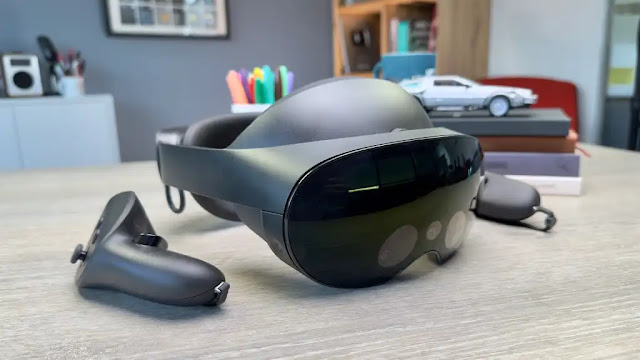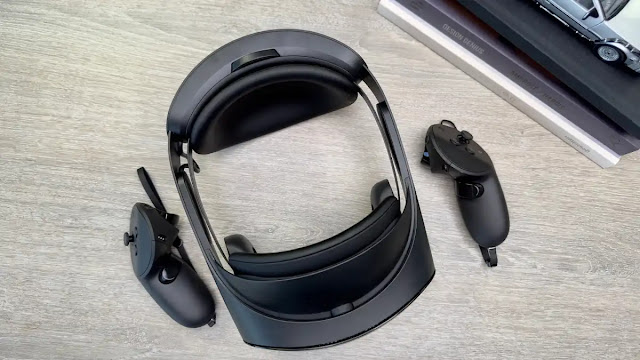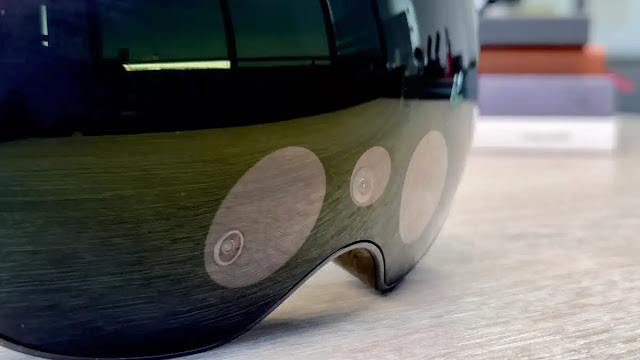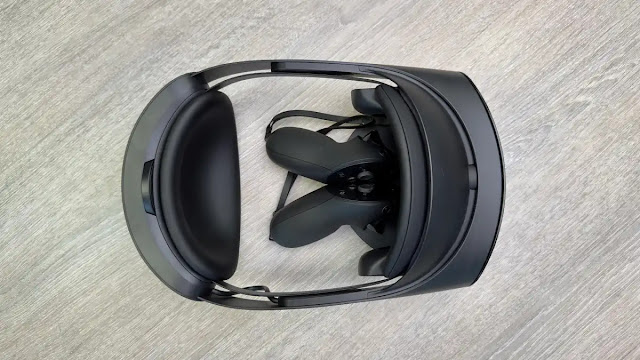The Quest Pro provides a glimpse at our mixed reality future.
Pros
- Face- and eye-tracking are huge for social VR
- Full-colour passthrough will be a boon for MR apps
- Redesigned, compact controllers
- Convenient charging station
Cons
- Very expensive
- Can become uncomfortable to wear over time
- No full light blocker included in the box
Our Verdict
- The Quest Pro is a capable headset that showcases what we should look forward to in the world of VR in the next few years, but the high price tag and comfort issues mean it’s only really for early adopters and those using it for work. Most people will still be perfectly happy with the standard Quest 2.
The Meta Quest Pro is Meta’s magnum opus, the result of years of internal R&D and investment into VR and MR – that’s virtual reality and mixed reality.
It’s a high-end headset for VR and MR enthusiasts with a high-end price tag to match, sporting features including face- and eye-tracking, full-colour passthrough for mixed reality, improved hand tracking and the best performance of any standalone VR headset on the market right now.
The question is, is it worth upgrading from the Meta Quest 2 or should you wait for the Meta Quest 3 next year? The answer isn’t as simple as you might expect…
Design & Build
- Streamlined form factor
- Incredibly compact HMD
- Can get uncomfortable over longer sessions
Meta (Facebook’s parent company) has been clear from the start that the Meta Quest Pro is a different beast entirely from the standard Quest 2 (formerly Oculus), and that’s most evident from the design of the headset.
It’s a complete departure from the shape, material and colour scheme of the standard Quest 2, with a much smaller head-mounted display (HMD) and a rigid head strap with a crank adjustment system similar to that of Meta’s optional Quest 2 Elite Strap.
The HMD truly is a marvel of engineering, coming in at less than half the width of the Quest 2 at 196mm for a much more compact form factor on the face. That’s down to a combination of a new pancake lens system that’s much thinner than the standard Fresnel-based lens system and Meta shifting the battery to the rear of the headset for better weight distribution – particularly important considering the Quest Pro weighs 772g, compared to the Quest 2’s 503g.
The improved fit and better weight distribution should translate to a more comfortable experience when donning the headset, and while that is the case with shorter bursts, the headset can still become uncomfortable over longer periods of use.
I’ve noticed a build-up of pressure on the forehead on two of the longer VR sessions during my week and a bit with the headset that became so uncomfortable that I had to stop using the headset for a while. That can be alleviated by loosening the crank on the rear of the headset, but then the headset becomes loose and moves slightly during use.
Fit and comfort aside, the Quest Pro sports an impressively wide IPD (inter pupillary distance) adjustment of 55-75mm, which comfortably beats the 56-70mm of the Quest 2 and 62-72mm of the competing Pico 4 and should accommodate most people.
The IPD adjustment system is much more granular than the Quest 2 with its three presets, and the Quest Pro can accurately measure your IPD using inward-facing cameras, though you still have to move the lenses yourself to get the right fit.
Display & Audio
- New pancake lens system improves optics
- No resolution bump, but things look clearer than Quest 2
- Impressive spatial audio support
The visuals are no doubt a highlight of the Quest Pro, boasting impressive clarity, even towards the edge of the frame where Fresnel-based systems like the Quest 2 begin to fall over. That’s because the Quest Pro sports a new pancake lens system that allows the headset to be much more compact than the standard Quest while providing improved optics.
It’s particularly interesting to note as the entry-level Quest 2 competitor, the Pico 4, has both a pancake lens system and higher resolution displays at 2160 x 2160 per eye while costing just £379 (around $400). If image quality is what’s most important to you, there could be a much cheaper option that could suit your needs.
Regardless of resolution specifics, there’s no noticeable screen door effect with the ability to clearly read text in VR without having to be right in front of it. That’s a boon not only for VR games, but working in virtual reality too.
The display is capped at 90Hz refresh rate in place of the experimental 120Hz of the Quest 2, but most people will struggle to notice the difference in everyday use.
The audio performance is equally as impressive despite no dedicated built-in headphones. Instead, the Quest Pro uses the same downward-firing speaker system as the Quest 2, which should be fine for both social VR and most VR games. I certainly had no complaints during my time with the headset.
I’m left wanting more in the bass department, which could be a dealbreaker for VR music titles like Beat Saber, but there’s always got the option of plugging in a pair of headphones via the 3.5mm headphone jack for improved audio performance and more privacy too.
Controllers
- Completely redesigned controllers
- Tracking doesn’t rely on the headset
- More compact, easier to use
With the redesigned Quest Pro comes redesigned Quest Pro controllers, and they really are a huge improvement on the standard Quest offering.
The first thing I noticed is that they’re much more compact, fitting comfortably into the palm of my hand with easy access to all the buttons and triggers. The button layout is essentially the same as that of the Quest 2, allowing for easy cross-headset compatibility with games and apps, with a new inward slanted area to rest your thumbs when not in use.
Of course, the standard Quest controllers don’t feature rings just for the fun of it, they’re used to track the location of the controllers by the headset. The Quest Pro controllers, on the other hand, boast a brand-new tracking system that doesn’t rely on the headset to track their location.
This is done using a smattering of small cameras across the controllers that, when combined with the Snapdragon 662 chipset found in each controller, can compute its position on the fly with true 1:1 accuracy. That means that there are no dead spots when tracking, no matter where the controllers are relative to the headset.
The freedom that controller-based tracking gives is relieving, especially when playing VR games like Blade and Sorcery: Nomad where you battle against human NPCs with swords, shields and magic powers (it’s a great game that I fully recommend if you haven’t checked it out!). While I occasionally lose tracking with the Quest 2 controllers, especially when reaching behind me to get my weapons, I didn’t experience that once with the Quest Pro controllers.
The Quest Pro controllers are also compatible with Quest 2 and will be sold separately for those looking to upgrade, though at $300/£300 a pop, I’m not sure how many will go for it.
Smart Features & Specs
- First headset to use the Snapdragon XR2+ Gen 1
- Eye- and face-tracking
- Mixed reality support via full colour passthrough
The Meta Quest Pro is the first VR headset on the market to feature Qualcomm’s updated Snapdragon XR2+ Gen 1 chipset alongside a boosted 12GB of RAM, and that means significant improvements.
That includes support for 8K@60fps 360-degree video, improved head, hand and controller tracking and a new image processing pipeline that supports full-colour passthrough (one of the headset’s main features) with just 10ms of latency, ideal for mixed reality applications – but more on that in a bit.
That’s hard to quantify in use, as the standard XR2 is both a decent chipset and the chipset most VR devs have tailored their games for, so there aren’t many (or any, really) titles that can take advantage of the extra power right now, but it certainly futureproofs the headset.
What’s equally, or possibly even more, exciting are the additions of face and eye-tracking tech. A first for a Meta headset, the Quest Pro can map your gaze and facial expression and use this data in VR apps like Horizon Workrooms to provide a much more lifelike social experience in virtual reality.
The new tech means those you communicate with will be able to pick up on smaller nuances of human communication, like smirks when joking, a sarcastic wink or wide-open eyes and mouth when a colleague says something shocking during a work meeting.
When combined with the hand-tracking already available on the Quest headsets, it’s a huge leap forward for social VR and collaboration, helping make virtual communication feel more natural, lifelike and simply more memorable than staring at an expressionless avatar.
On a less exciting but still important note, the Quest Pro comes with a boosted 256GB of storage as standard, allowing you to install all kinds of VR games and MR apps without having to worry about running out of space. With some titles like Medal of Honor: Above and Beyond coming in at a whopping 44GB, the extra capacity is appreciated.
There’s also support for Wi-Fi 6E and Bluetooth 5.2, though the headset still can’t be used with Bluetooth headphones, unlike the competing Pico 4 headset.
The MR/VR Experience
- Mixed reality is exciting, but not many apps use it at the moment
- Still need to manually map your room for MR
- VR experience is identical to Quest 2, except without full light blocker
While the Meta Quest Pro is just as capable as the Quest 2 when it comes to VR (virtual reality), the Pro model holds the upper hand when it comes to mixed reality, also known as MR (mixed reality).
That’s powered mainly by upgraded full-colour cameras mounted onto the front of the headset that boasts 4x the pixels of the standard Quest. That not only means you’ll be able to see your environment in colour for the first time, but it’s of a much higher quality than the Quest 2.
With that in mind, the Quest Pro is best placed to offer a high-end mixed reality experience, blending the real and virtual worlds. Depending on the app, this can take a bit of setup, though. Apps like I Expect You To Die: Home Sweet Home require you to map the walls in your room, while the MR view in Horizon Workrooms requires you to first map your desk and laptop/keyboard (if compatible) – but the results are often worth it.
MR feels comfortable, partly down to the open periphery design of the headset that lets you see the real world in your periphery to help blend the two together. It allows you to stay grounded in the real world while experiencing the magic of MR. Admittedly, there isn’t a lot of MR content right now, but that should change in the coming months.
Beyond colour passthrough and MR, the Quest Pro is tailored to work and collaboration, and Meta has timed an update to Horizon Workrooms to coincide with its release.
The ability to sit at an empty desk, put a headset on and work across three large virtual monitors while still being able to see the room is an absolute treat, especially for those with limited space at home. It’s a great introduction to MR and a taste of what’s to come.
VR-wise, the Quest Pro performs exactly as you’d expect, with top-tier performance across all kinds of titles from Beat Saber to Bone Lab, though the magnetic side-blockers provided with the headset let light in from the bottom of the headset. For a fully immersed experience, you’ll need to purchase the optional full light blocker.
Battery Life & Charging
1.5 to 2 hours of battery life
Can be extended by disabling face- and eye-tracking
Charged via convenient contact charging pad
Interestingly, battery life is one area where Meta’s Quest 2 outdoes the Quest Pro. As standard, the regular Quest 2 can officially last around 2-3 hours, while the Quest Pro can only officially last around 1.5-2 hours before it’ll need a top-up.
I found that largely true to life in use, usually squeezing around 90 minutes of use out of the headset before being warned about low battery, and sometimes I even got close to the two-hour mark. That’ll be fine for most people, especially considering Meta pitches this as a headset you’ll use little and often for work purposes, but it won’t satiate the needs of hardcore VR gamers that invest in the headset.
There is a caveat to all this, however. Battery life can be improved to match the Quest 2, extending use to around three hours, but you’ll have to disable both the face and eye tracking to do so. That’s handy if you want to game in VR, but given the collaborative and social focus of the Quest Pro, and the fact that those are two of the headset’s key features, it’s not the perfect solution.
Meta says that you can plug the headset in if you want to use the headset for longer periods, such as when working at a desk in VR using Workrooms or Virtual Desktop. This requires the included 2m USB-C cable, which won’t do much for VR gamers.
Price & Availability
With all that high-end tech, the Meta Quest Pro is a high-end product with a price tag to match – though the actual $1,499/£1,499 price tag can still be a shock, coming in at just under 4x the price of the $399/£399 Meta Quest 2 and comfortably higher than any standalone VR headset on the market in 2022.
In fact, it’s more expensive than the high-end Vive Pro 2, though you’ll need a beefy gaming PC to run Vive’s VR headset.
If the temptation of new VR tech is too much to resist, the Meta Quest Pro is available to buy from Meta itself alongside key retailers like Best Buy in the US and Amazon in the UK. We cover where to buy the Meta Quest Pro in more detail separately for those interested.
If you’re curious how the Meta Quest Pro compares to other headsets available, take a look at our selection of the best VR headsets.
Verdict
The Quest Pro is an impressive bit of hardware, giving us a good look at what to expect from future Meta VR headsets including the Quest 3. The face- and eye-tracking capabilities are exciting, bringing a new level of human communication to social VR apps and collaboration, and the full-colour passthrough gets me excited for the future of mixed reality.
There’s also the new open-periphery design, complete with a much more compact HMD and more centrally balanced weight distribution than the Quest 2, though it can become uncomfortable to use over longer periods in my experience.
The experience is further complimented by the new Quest Pro controllers that bring improved tracking and better haptics in a smaller form factor, and the magnetic light blocker accessories that snap into place on the headset when you want to experience a more immersive VR experience.
The only real barrier is the price tag, coming in at a cool $1500/£1500 that puts it firmly out of the grasp of everyday consumers. It’s arguably more tailored towards early adopters that want to experience the latest in VR than those that want to play Beat Saber every now and again.
The question is, is it worth upgrading from the Quest 2? It depends really. The face- and eye-tracking are cool features, but considering the incredibly high price tag for the headset, you’ll really need to be sure you’ll get use out of them.
Colour passthrough does make the headset more tempting for those interested in mixed reality, but if your focus is purely VR, the longer battery life and full light blockers of the Quest 2 will serve you better (and cheaper).
Specs
- Display Panels: 2 x LCD panels with Mini LED backlight
- 1800 x 1920 pixels per eye
- 72/90Hz
- Field of view: 106° horizontal and 96° vertical
- IPD range: 55mm-75mm
- Snapdragon XR2+ Platform
- 12GB RAM
- 256GB storage
- Wi-Fi 6E
- Bluetooth 5.2
- Tracking/Sensors: 10 advanced VR/MR sensors to support 6 degrees of freedom inside-out SLAM tracking, as well as colour mixed reality and eye/face tracking
- Integrated speakers and microphone; also compatible with 3.5mm earphones via twin left/right jacks
- 1-2 hours of battery life
- 2m charging cable can be used to provide extra power during use. Full charge in 2 hours
- Charging base included
- 265mm (L) x 127mm (H) x 196mm (W) (265mm length assumes minimum strap setting)
- 722g
















0 comments:
Post a Comment